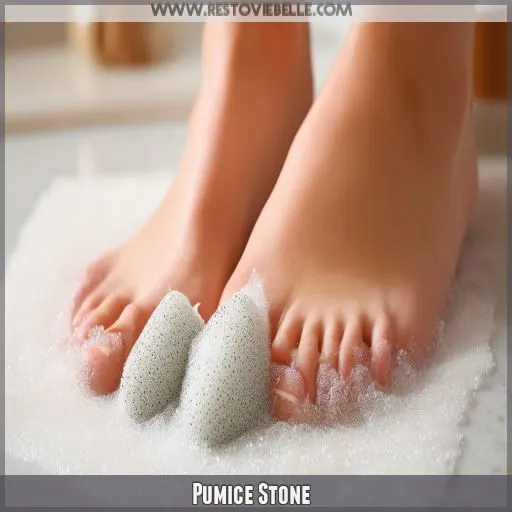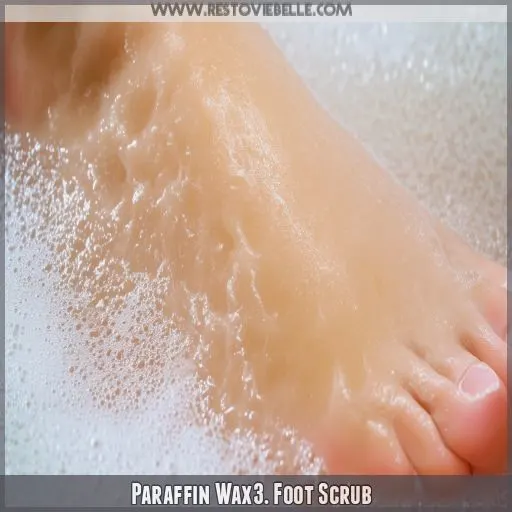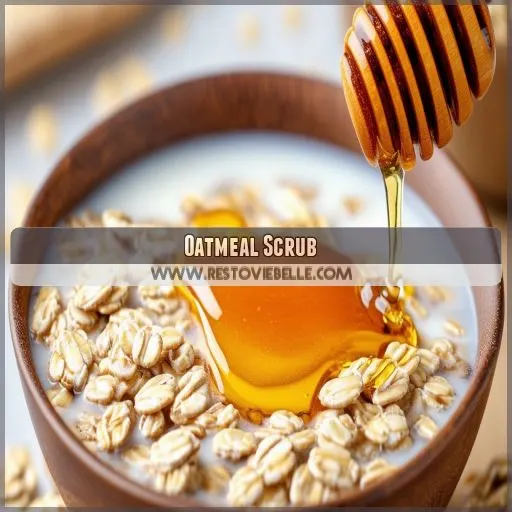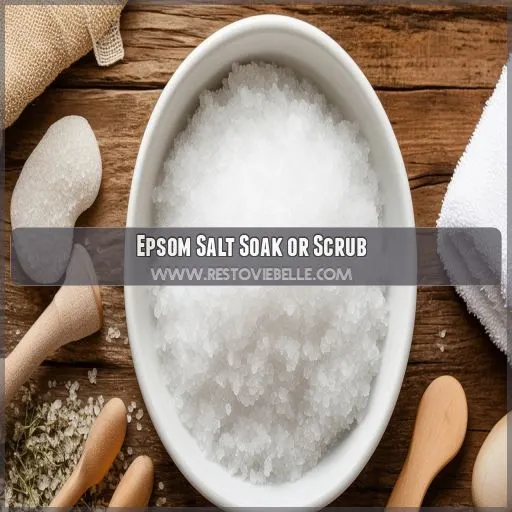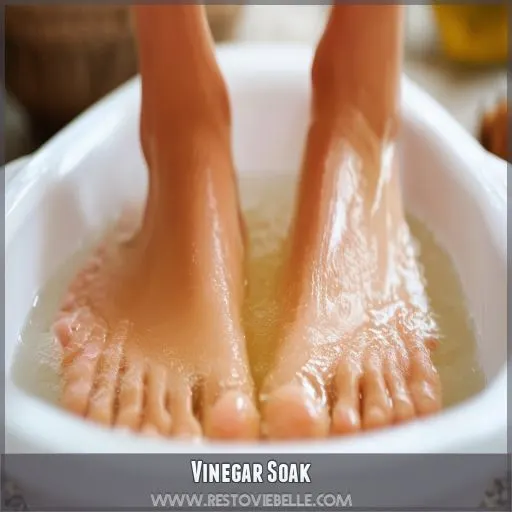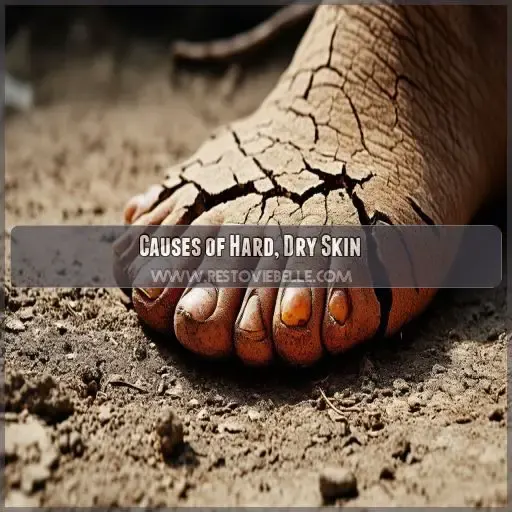This site is supported by our readers. We may earn a commission, at no cost to you, if you purchase through links.
 Struggling with rough, dry feet? You’re not alone. Dead skin buildup is common, but you can easily tackle it at home.
Struggling with rough, dry feet? You’re not alone. Dead skin buildup is common, but you can easily tackle it at home.
This guide explores six effective methods to remove dead skin from your feet, giving you smoother, healthier soles. From pumice stones to vinegar soaks, you’ll discover simple techniques using everyday items.
Understanding the causes of hard, dry skin is key to prevention. By mastering these at-home remedies, you’ll gain the freedom to confidently bare your feet without embarrassment.
Let’s embark on these easy, proven methods.
Table Of Contents
- Key Takeaways
- How to Remove Dead Skin From Your Feet – 6 Easy Methods to Try?
- Pumice Stone
- Paraffin Wax3. Foot Scrub
- Oatmeal Scrub
- Epsom Salt Soak or Scrub
- Vinegar Soak
- Causes of Hard, Dry Skin
- Frequently Asked Questions (FAQs)
- How do I get dead skin off my feet ASAP?
- How do you get dead hard skin off your feet?
- How can I peel my feet fast?
- What is the best way to get rid of hard skin on feet?
- How often should I remove dead skin from feet?
- Can removing dead skin make feet more sensitive?
- Are electric foot files safe for removing dead skin?
- Does diet affect dead skin buildup on feet?
- Can I use body lotion instead of foot cream?
- Conclusion
Key Takeaways
- Got feet that feel like sandpaper? Don’t worry, you’re not walking alone! From pumice stones to paraffin wax, there’s a buffet of options to get your tootsies touchably soft. Just remember, slow and steady wins the race – no need to go overboard and end up with tender toes!
- Turns out, your kitchen might be a secret spa! Who knew that oatmeal wasn’t just for breakfast, or that vinegar could do more than dress your salad? These household heroes can work wonders on your weary feet. So next time you’re cooking, your feet might be eyeing the ingredients too!
- Prevention is better than cure, as they say. Understanding why your feet are throwing a dry skin party can help you stop it before it starts. From staying hydrated to keeping those toes out of the sun, a little TLC goes a long way in keeping your feet flip-flop ready.
- Remember, if your feet are giving you more trouble than a pebble in your shoe, it might be time to give your doc a ring. Sometimes, those stubborn spots could be trying to tell you something more. Better safe than sorry when it comes to your hardworking feet!
How to Remove Dead Skin From Your Feet – 6 Easy Methods to Try?
Wondering how to remove dead skin from your feet? Try these 6 easy methods:
First, use a pumice stone to gently scrub away rough patches. For deep moisturizing, apply paraffin wax and peel it off. Create a DIY foot scrub with sugar or salt for exfoliation. Mix oatmeal, honey, and olive oil for a soothing scrub. Soak your feet in Epsom salt to soften skin before exfoliating. Finally, try a vinegar soak to dissolve dead skin cells.
Let’s explore these methods in more detail.
Pumice Stone
You’ve probably heard of pumice stones, those lightweight volcanic rocks that can work wonders on your feet. They’re incredibly effective at exfoliating and removing dead skin, leaving you with smoother soles.
To use one, start by soaking your feet in warm water for about 10 minutes to soften the skin. Then, gently rub the pumice stone in circular motions over rough areas, focusing on calluses and dry patches. Don’t go overboard – a light touch is all you need to slough off dead skin cells. Rinse your feet and pat them dry.
For best results, use your pumice stone once or twice a week. Remember, consistency is key for keeping your feet baby-soft. With regular use, you’ll be saying goodbye to rough skin and hello to silky-smooth feet in no time!
Paraffin Wax3. Foot Scrub
While pumice stones are great for manual exfoliation, paraffin wax and foot scrubs offer a more luxurious approach to removing dead skin. Paraffin wax treatments not only exfoliate but also deeply moisturize your feet, making them ideal for tackling stubborn dry skin and cracked heels. Here’s how to use these methods effectively:
- Apply warm paraffin wax to your feet, focusing on callused areas.
- Wrap your feet in plastic and let the wax work its magic for 20 minutes.
- Peel off the wax, taking dead skin with it.
For a quicker alternative, try a foot scrub. Look for products containing exfoliating ingredients like sugar or salt, combined with moisturizing agents such as shea butter. Gently massage the scrub onto damp feet in circular motions, paying extra attention to rough spots. Rinse thoroughly and follow up with a rich moisturizer to lock in hydration.
Oatmeal Scrub
You’ll love the oatmeal scrub for its exfoliating benefits and soothing properties. It’s a gentle yet effective way to remove dead skin and hydrate your feet. Here’s a quick guide to make your own oatmeal scrub:
| Ingredient | Amount | Benefits |
|---|---|---|
| Oatmeal | 1/2 cup | Exfoliates |
| Honey | 2 tbsp | Moisturizes |
| Olive oil | 1 tbsp | Softens skin |
| Warm water | As needed | Binds mixture |
Mix these ingredients to form a paste. Apply it to your feet, gently massaging in circular motions. Let it sit for 10-15 minutes before rinsing off with warm water. You’ll notice smoother, softer skin immediately.
Can’t find oatmeal? Try baking soda as an alternative. It’s just as effective at sloughing off dry skin. Remember, if you have any skin irritation, do a patch test first. Your feet will thank you for this nourishing treat!
Epsom Salt Soak or Scrub
After exfoliating with an oatmeal scrub, you might want to try an Epsom salt soak or scrub for your feet. This mineral-rich treatment softens dead skin and also provides a soothing experience. Epsom salt’s exfoliating properties make it an excellent choice for removing dry, flaky skin from your feet.
To create an effective Epsom salt foot treatment:
- Mix 1/2 cup of Epsom salt with 1/4 cup of olive oil or cocoa butter
- Add a few drops of your favorite essential oil for fragrance
- Gently massage the mixture onto your feet, focusing on rough areas
Soak your feet in warm water with dissolved Epsom salt for 15-20 minutes. The minerals will penetrate your skin, helping to soften calluses and relieve tension. After soaking, use a pumice stone to remove loosened dead skin. Remember, this method isn’t just for feet – it can also help with dry lips and a dry face.
Vinegar Soak
After exfoliating with Epsom salt, why not try a vinegar soak? This acidic treatment can help soften and remove stubborn dead skin. You’ll need just a few simple ingredients from your kitchen. Here’s a quick guide to get you started:
| Vinegar Type | Soak Duration | Benefits |
|---|---|---|
| White | 15-20 minutes | Softens skin |
| Apple Cider | 10-15 minutes | Balances pH |
| Rice | 20-25 minutes | Nourishes |
| Balsamic | 5-10 minutes | Exfoliates |
| Red Wine | 15-20 minutes | Smoothens |
Mix equal parts vinegar and warm water in a basin. Soak your feet for the recommended time, then gently scrub with a pumice stone. For an extra boost, add a splash of lemon juice. This overnight treatment works wonders for cracked heels. Remember, consistency is key – regular soaks will keep your feet silky smooth.
Causes of Hard, Dry Skin
Your feet can develop hard, dry skin due to various factors, including lack of moisture, environmental conditions, and certain medical issues. Understanding these causes can help you prevent and address dead skin buildup more effectively, leading to healthier, smoother feet.
Lack Of Moisture
Your feet lack natural oil glands, making them prone to dryness. Without proper care, you’ll likely experience cracked heels, dry soles, and flaky skin. Lack of moisture leads to rough patches and callus formation. To combat this:
- Moisturize daily with petroleum jelly
- Wear cotton socks to lock in hydration
- Use natural remedies like mashed banana or brown sugar scrubs
Don’t let your feet become a desert! Keep them hydrated for smooth, healthy skin.
Environmental Factors
Environmental factors, beyond just lack of moisture, significantly impact foot health. Aging, genetics, and sun exposure can all contribute to dry, hard feet.
Daily habits play a crucial role: staying hydrated and exercising regularly can help maintain foot health. However, be cautious with tools like razors or electric callus removers.
For stubborn cases of dry, hard feet, try a salicylic acid foot peel.
Medical Conditions
Medical conditions can contribute to hard, dry skin on your feet. Here are some common culprits:
- Athlete’s foot: A fungal infection causing itchy, flaky skin
- Eczema: Leads to dry, cracked, and itchy patches
- Diabetes: Can cause nerve damage and poor circulation
- Psoriasis: Triggers rapid skin cell turnover
- Dermatitis: Causes inflammation and itching
While treatments like baby foot peels or lemon water soaks may help, it’s essential to consult a doctor for proper diagnosis and treatment of these underlying conditions.
Frequently Asked Questions (FAQs)
How do I get dead skin off my feet ASAP?
A stitch in time saves nine." To quickly remove dead skin from your feet, soak them in warm water for 20 minutes, then gently scrub with a pumice stone. Follow up with a moisturizing foot cream for best results.
How do you get dead hard skin off your feet?
To remove hard dead skin from your feet, soak them in warm water for 20 minutes. Then, gently scrub with a pumice stone or foot file. Apply a rich moisturizer and wear cotton socks overnight for best results.
How can I peel my feet fast?
To peel your feet fast, try a foot peel mask. Apply it for an hour, then rinse. Within a week, dead skin will start shedding. Alternatively, soak feet in warm water and exfoliate with a pumice stone.
What is the best way to get rid of hard skin on feet?
Did you know 20% of adults struggle with foot calluses? To tackle hard skin, soak your feet in warm water, then gently exfoliate with a pumice stone. Follow up with a moisturizing cream to keep your feet soft and smooth.
How often should I remove dead skin from feet?
You should remove dead skin from your feet once or twice a week. If you’ve got excessive buildup, start with twice weekly sessions, then reduce to once a week for maintenance. Don’t overdo it; excessive exfoliation can damage healthy skin.
Can removing dead skin make feet more sensitive?
Like a butterfly emerging from its cocoon, your feet may feel tender after shedding dead skin. You’ll likely experience increased sensitivity temporarily. This is normal and often subsides as new skin toughens. Don’t overdo it to avoid discomfort.
Are electric foot files safe for removing dead skin?
Electric foot files can be safe when used correctly. They’re effective for removing dead skin, but you’ll need to be cautious. Don’t overuse them, as this could damage healthy skin. Always follow the manufacturer’s instructions for best results.
Does diet affect dead skin buildup on feet?
Like a garden needs nutrients, your feet crave a balanced diet. You’re what you eat, so nourish your body with hydrating foods and essential nutrients. This can reduce dead skin buildup and keep your feet smoother.
Can I use body lotion instead of foot cream?
You can use body lotion, but it’s not ideal. Foot creams are thicker and more moisturizing, designed for tough foot skin. If you’re in a pinch, body lotion will do, but invest in a good foot cream for better results.
Conclusion
Armed with these six easy methods to remove dead skin from your feet, you’re now ready to step into smoother, healthier soles. From pumice stones to vinegar soaks, you’ve learned effective techniques using everyday items.
Don’t let rough feet hold you back – with these simple strategies, you can confidently put your best foot forward.

